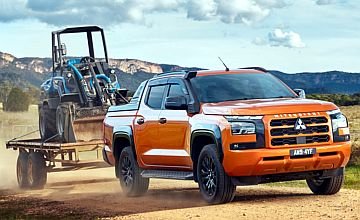Make / Model Search
OptionsCar reviews - Mitsubishi - Triton - GSRMitsubishi modelsOverviewWe like Impressive fuel economy towing, decent overall engine performance, looks good in high-spec trim, capable off-roader, tows up to 3500kg, decent size 75-litre fuel tank, more accessible pricing than direct competitors, long conditional warranty Room for improvement Usual intrusive default-on ADAS gripes, annoying default-on idle-stop, clattery diesel engine noise, tyre grip in wet, Adblue adds to running costs, jiggly unladen ride, no paddle shift, at times baulky automatic transmission We put the Mitsubishi Triton GSR to work, the ute coming up trumps in a 2500kg tow test14 Apr 2025 Overview
AS ITS name suggests a ute (utility) must be able to cope with broad applications from toting a tonne in the tray to carrying tradie tools/products, carry out light delivery work and tow every imaginable rig spanning boats, trailers, caravans and machinery.
We were able to hook up a trailer-borne fork lift to the road test 2170kg Triton GSR that weighed in at a touch over two and a half tonnes including the dual axle trailer, well below the 3500kg Triton braked towing limit and also well below its Gross Combined Mass (GCM) at 6250kg.
It allowed us to take three people in the cab and a pile of stuff in the tray the exercise giving us an insight into how the $63,840 +ORC Triton GSR tows, its strengths and weaknesses and whether we would put down our hard earned on one or look elsewhere.
Alternatives include Nissan’s Pro 4X Warrior from $69,143 + ORC, Toyota’s HiLux GR Sport from $74,310 +ORC, Isuzu’s D-Max X-Terrain from $67,900 d/a and the Ford Ranger Wildtrak 2.0 from $69,648 + ORC … to name a few.
To be honest, the Triton’s lower price has strong appeal as, comparing apples with apples as much as possible, it is thousands less than the direct competitor one tonners from established brands though considerably more than similar offerings from China and South Korea.
Topping the Triton range, the GSR features a full raft of ADAS tech that was recently revised to make it more amenable for owners particularly tradies many of whom had lodged complaints with dealers about its intrusive nature.
It is also equipped with a generous array of comfort and practical features adding to the value equation.
The GSR’s inventory of goodies lists leather upholstery, a six-speaker audio system, hard wired satnav, phone charging pad, a multi-info screen, 18-inch black alloys, sailplane bar, tub liner, black body hardware including roof rails and wheel mouldings and shift on the fly 4WD facility.
The GSR and all other Tritons for that matter are powered by a comprehensively revised 2.4-litre bi-turbo diesel four-cylinder engine based on the previous single turbo unit now rated at 150kW/470Nm.
The twin turbo assembly is fitted with an integrated DPF and AdBlue injection, all in one unit under the bonnet. Mechanics spoken to loved the setup due to the potentially easy maintenance and its compact size.
The model scores seven drive modes and is driven via Mitsubishi’s Super Select 4WD II system with 2H, 4H (full time 4WD), 4HLc and 4LLc the latter two in reference to a locking centre differential for added traction.
Other appealing features are the LED headlights, double wishbone front and softer leaf spring rear suspension, electric power steering, full size spare, reversing camera, rear step and auto headlights, wipers and cruise control. There’s plenty more too.
Driving Impressions
A tow ball down weight of 350kg means you can hook up a heavy rig behind the Triton which is what we did. It was a tonne short of the 3500kg limit but served to demonstrate the vehicle’s prowess during one of its core applications.
Minimal rear sag was evident, the Triton adopting a level stance with the rig on the back… a good sign as having everything level is a big plus.
At 470Nm, the “new” engine has nearly the segment benchmark torque of 500Nm delivered from a low engine speed of 1500-2750rpm. Redline is a touch over 4000rpm but the Triton is happiest under 3000.
It pulled the load easily up hill and down dale exhibiting the ability to accelerate on long uphill freeway stretches, sometimes necessitating a downshift effected through a parallel gate on the selector.
It seemed to make little difference which mode the Triton was in, so we left it in Normal allowing the gearbox and engine to sort it all out.
An annoying clattering noise emanates from under the bonnet that was not evident on a previous model Triton along for the drive.
We presume it was from the high mount turbo/emissions system just under the bonnet busily doing its job.
Then it started raining and this is where the fun began as the vehicle was in 2WD (rear) and was losing traction under acceleration at speed that is most disconcerting with a trailer in tow.
The Triton GSR’s Highway Terrain (H/T) tyres are not up to the job towing in RWD in the wet, so we put the selector in 4H giving constant AWD that solved the problem.
Funny thing is it made little or no difference to fuel consumption at 9.8 litres per 100km the super respectable number only marginally greater than some competitor utes achieve unladen. General running around saw the vehicle consume 8.2L/100km.
With 75 litres in the tank, the test car would have a theoretical range of around 700km… towing!
In crosswinds at speed, the rig tended to move about a bit although that was easy to keep in check with the responsive steering and the brakes were up for anything we dished out.
The six-speed auto can at times be caught napping in the wrong gear, but manual selection overcomes the issue.
Once or twice, it clonked down a cog unnecessarily with an accompanying jolt but on the upside, six gears are all you really need in a ute (or any vehicle for that matter) as it has nice long runs through each ratio and doesn’t spend all its time hunting up and down the range.
We found the ADAS intervening unnecessarily at times and suggest most of it should be turned off when towing lest it spear you where you don’t want to go or panic brake unexpectedly… and other dangerous scenarios.
The cabin is comfortable, well-appointed and easy to use though perhaps with too many menus to access for vehicle set-up. This would be problematic for a tradie who gets in and out numerous times a day.
Overall, we would recommend the Triton even though it’s only marginally better than its predecessor. The price is competitive, it looks good in high spec’ variants and is a capable workhorse.
Perhaps a favourites button that saves driver preferences would be an improvement for most buyers/owners instead of wasting time menu searching at every start-up.
 Read more3rd of April 2025  Mitsubishi adds body styles to Triton rangeMore Triton choices available soon as cab-chassis, Single and Club cabs filter through4th of February 2025  Mitsubishi introduces Triton GSR Special EditionFlagship dual-cab ute arrives in Mitsubishi range, Triton GSR Special Edition from $63,1402nd of October 2024  Mitsubishi adds Triton GLX-R variantRunning changes see addition of GLX-R variant to Mitsubishi Triton line-upAll car reviews Alfa Romeo Alfa Romeo Abarth Abarth Audi Audi Aston Martin Aston Martin BMW BMW Bentley Bentley Chrysler Chrysler Chevrolet Chevrolet Dodge Dodge Citroen Citroen Ferrari Ferrari DS DS Ford Ford Fiat Fiat FPV FPV Foton Foton Haval Haval Great Wall Great Wall Honda Honda Holden Holden Hyundai Hyundai HSV HSV Isuzu Isuzu Infiniti Infiniti Jaguar Jaguar Iveco Iveco Kia Kia Jeep Jeep Land Rover Land Rover Lamborghini Lamborghini Maserati Maserati Lexus Lexus McLaren McLaren Mazda Mazda Mercedes-Benz Mercedes-Benz Mitsubishi Mitsubishi Mini Mini Opel Opel Nissan Nissan Porsche Porsche Peugeot Peugeot Ram Ram Proton Proton Rolls-Royce Rolls-Royce Renault Renault Skoda Skoda Saab Saab SsangYong SsangYong Smart Smart Suzuki Suzuki Subaru Subaru Toyota Toyota Tesla Tesla Volvo Volvo |
OptionsClick to share
|











Facebook Twitter Instagram